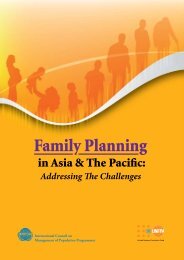Inter-lInkages between PoPulatIon DynamIcs anD DeveloPment In ...
Inter-lInkages between PoPulatIon DynamIcs anD DeveloPment In ...
Inter-lInkages between PoPulatIon DynamIcs anD DeveloPment In ...
You also want an ePaper? Increase the reach of your titles
YUMPU automatically turns print PDFs into web optimized ePapers that Google loves.
A review of the Eleventh Five-Year Plan (2007-2012) shows that most sectors take into account theconsequences of population dynamics. They also segment the population depending on their characteristics.However, population variables are still considered as independent variables irrespective of the changes indevelopment variables. The population projections are made generally based upon past trends in view of thecomplexity and uncertain nature of the impact of development variables on fertility and mortality, and overtimeon age-sex composition and population distribution.The Eleventh Plan has two promising practices: (i) Focus on inclusive growth; and (ii) the National RuralHealth Mission (NRHM). However, several challenges remain: adverse gender-sex ratio at birth, reaching thepoor, special attention to youth, migrants and HIV prevention, water, and urbanisation. Besides addressingthese challenges, the implementation for operationalising POPDEV inter-linkages needs to be strengthenedthrough (i) integrating POPDEV considerations in national and state planning; (ii) coordinated sectoral responseat district level; (iii) cross-sectoral collaboration at block level; and (iv) integrated response at village level.Malaysia’s Experience in POPDEV <strong><strong>In</strong>ter</strong>-linkages in Its Policy and Planning Framework<strong>In</strong> Malaysia, the policies on population, women, health, HIV/AIDS and employment acknowledge the manyrelationships <strong>between</strong> POPDEV. Also, the policies have moved away from the conventional focus - impact ofpopulation growth on development - due to the nation’s declining fertility rate. The core emphasis is onenhancing the standard and sustaining the quality of life of Malaysians. Nevertheless, the policy frameworkneeds to pay more attention to address issues on the nexus <strong>between</strong> population and development in theMalaysian context.A review of the Ninth Malaysia Plan (2006-2010) shows that most sectors take into consideration the POPDEVinter-linkages. Combined with strong implementation this contributes to the development of Malaysia’seconomy and improved quality of life of Malaysians. However, the inter-linkages of population dynamics anddevelopment need to be strengthened in some sectors, namely, HIV/AIDS, infrastructure and environment.The Ninth Plan has two promising practices: (i) Poverty reduction, which will have significant impact onensuring a more equitable distribution of the benefits of economic development among all Malaysians; and(ii) Women’s empowerment.Several challenges remain: (i) to achieve universal access to RH by 2015 there is a need to define thesignificance of RH, including FP, and emphasise this in national planning; (ii) the need to articulate the interlinkagesof POPDEV to address the feminisation of HIV/AIDS, drug addiction as well as unemployment andHIV/AIDS and its potential spread to the general populations; and (iii) migrant workers, being a sensitiveissue, need to be featured in the inter-linkages of POPDEV in the Malaysian context and in national planning.Finally, to effectively address inter-linkages of POPDEV, the following is recommended: integrating POPDEVconsiderations in national and state planning; coordinating sector response at district level; cross-sectoralcollaboration at sub-district level; and integrating response at town level as well as increasing awareness andresponse at various levels to enhance population dynamics and its inter-linkages.vi














